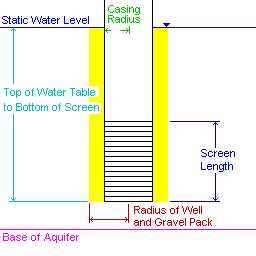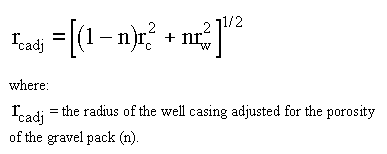Aquifer Parameters
Edit | Aquifer Parameters
See Also:
This diagram illustrates the aquifer parameters entered. Values for each parameter must be entered to run the slug tests. Units are specified from Options | Units.

Hydraulic Conductivity Ratio -- This is the ratio of horizontal hydraulic conductivity to vertical hydraulic conductivity. This parameter is required only for the Hvorslev methods for partially penetrating wells. If the horizontal hydraulic conductivity of the aquifer material is equal to the vertical hydraulic conductivity, this value will be 1.0.
This value will not normally be known prior to the slug test and must be estimated based on the aquifer material. Sandy materials will have a ratio close to 1.0 whereas increasing clay content will raise this value by 1 or 2 orders of magnitude to 10 or 100 (vertical conductivity will normally be less than horizontal). Rarely will this value be less than 1.0 (greater vertical conductivity than horizontal).
Well Casing Radius -- The internal radius of the well casing where the water level is raised or lowered during the slug test.
Radius of Well and Gravel Pack (effective well radius) -- The radius of the gravel pack, which is typically the radius of the well borehole. This value will be used when calculations call for the effective well radius.
Screen Length -- The length of the well screen within the aquifer. If the screen sticks above the aquifer, the Bouwer and Rice calculations automatically assume screen length to be only the length of the screen within the aquifer. Only the Bouwer and Rice method makes this adjustment. See Bouwer and Rice descriptions for more information.
Saturated Aquifer Thickness -- For a confined aquifer, this is the distance from the base of the upper confining unit to the top of the lower confining unit. For an unconfined aquifer, this is the distance from the water table to the top of the lower confining unit.
Top of Water Table to Bottom of Screen -- For fully penetrating wells, this value will be the same as the aquifer thickness. For partially penetrating wells, this is the distance from the water table surface for unconfined aquifers (or base of the confining unit for confined aquifers) to the bottom of the well screen.
Static Water Level -- This is the water level in the well prior to the injection or withdrawal of the slug. It must be relative to the same datum as the drawdown values.
Bouwer and Rice Porosity Adjustments
Herman Bouwer (1989) provides an equation for the corrected radius of the well casing. This correction should be used only for rising head slug tests where the static water level before the test is below the top of the well screen.
The formula for the equation is given as:

Include the Herman Bouwer (1989) Gravel Pack Porosity Correction -- If this box is checked, the Bouwer and Rice Graphical and Automatic methods will use a value of well casing radius adjusted with the above formula. If this box is not checked, the correction will not be made. This correction is used only in the Bouwer and Rice methods.
The adjusted casing radius and porosity estimate will be displayed in all applicable graphs and reports.
Porosity of the Gravel Pack -- This is the porosity of the gravel pack (expressed as a decimal). It is usually estimated based on the material used to construct the gravel pack. If the option to correct for gravel pack porosity is not checked, this value is ignored.